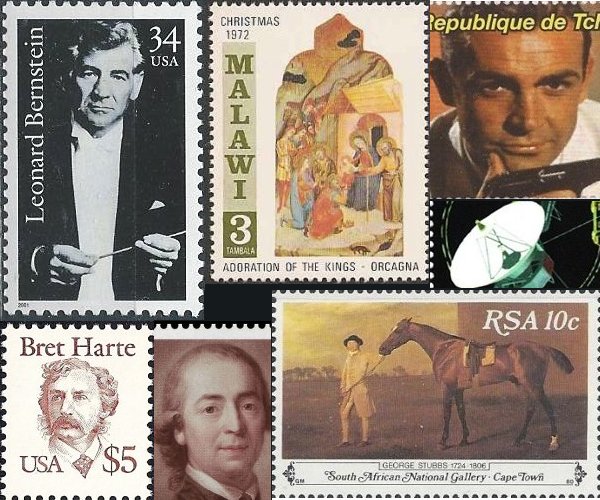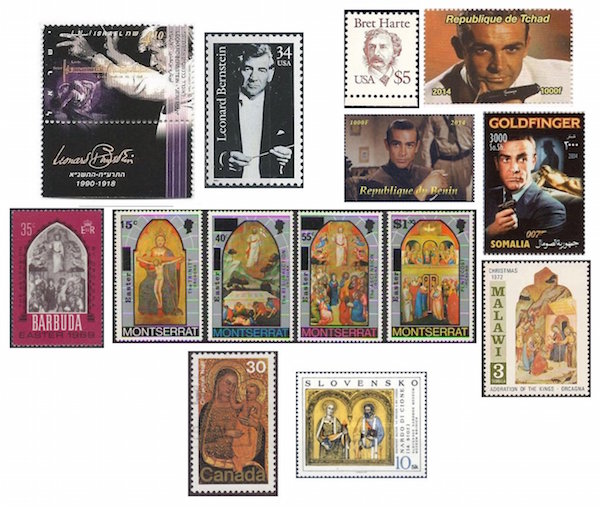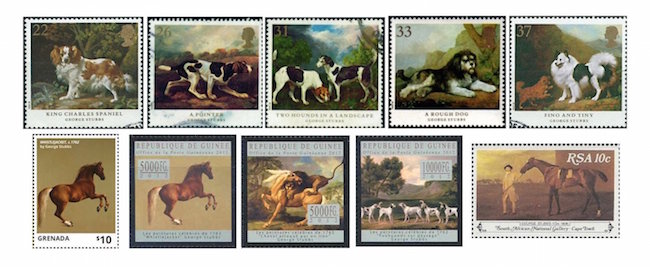The Arts on Stamps of the World — August 25
An Arts Fuse regular feature: the arts on stamps of the world.

By Doug Briscoe
Among our more prominent honorees today are Leonard Bernstein, Bret Harte, and Sean Connery.
The unforgettable and brilliant conductor, composer, pianist, and consummate lecturer Leonard Bernstein (25 August 1918 – October 14, 1990) will have his centenary next year. A couple of years ago I heard that Martin Scorsese was planning to direct a biopic on Bernstein, but I don’t know whether that’s still in the works. The Israeli Bernstein stamp came out in 1995, paired with the Ernest Bloch stamp we showed here last month; the US issue dates from 2001.
American short story writer and poet Bret Harte (August 25, 1836 – May 5, 1902) is best remembered for his depictions of the kinds of characters who thrived (or not) during the California Gold Rush. He was born, however, in Albany, New York to a Jewish Orthodox immigrant merchant. Harte was 17 before he saw California. Certainly he worked as a miner, but also as a teacher and journalist. He also rode shotgun for Wells Fargo. A report he wrote about an appalling slaughter of Wiyot Indians earned him death threats from the kind of people who today wear MAGA caps, and he relocated to San Francisco. His story “The Luck of Roaring Camp” and poem “Plain Language from Truthful James” put Harte’s name on the map. He came back east but soon found himself and his family in desperate financial straits until he accepted a diplomatic post in Germany. He lived in Europe, separated from his family, for the next two dozen years, writing prolifically. Composers Samuel Adler and Stanford Beckler both have written operas based on “The Outcasts of Poker Flat”. Harte was chosen for the highest ($5) denomination in the 1986-97 series of prominent Americans definitive stamps.

Happy birthday, Sean Connery (born August 25, 1930)! I show a few James Bond stamps from Chad, Benin, and Somalia.
Now let us go back seven hundred years and commemorate the passing on this date in 1368 of the Florentine painter, sculptor, and architect Andrea di Cione di Arcangelo (born c1308), better known as Orcagna. He is regarded as the finest in a family of artists, a couple of whom we shall also salute today, as their precise dates of birth and death are unknown. On a stamp of Barbuda issued for Easter 1969 we see a black-and-white version of Orcagna’s Ascension, seen also in color on the third of a set of four stamps from Montserrat, along with his Trinity, Resurrection, and Pentecost. A word about this set: it was intended for issuance in 1975, but for some reason the production was delayed, so when it came out in 1976 the stamps were overprinted with bars crossing out the “1975” date and with new denominations. Finally we have from Malawi Orcagna’s Adoration of the Kings. Among his other works is the facade for Orvieto Cathedral. His fresco The Triumph of Death was the direct inspiration for Franz Liszt’s Totentanz for piano and orchestra. (We have another Liszt connection later.) A brief word about Orcagna’s brothers, whose work also appears on stamps. Jacopo di Cione (c1325 – after 1390) is remembered with his Virgin and Child on a Canadian Christmas stamp of 1978, and the work of Nardo di Cione (died c1366), the Bojnice Altarpiece (Saints Lucy & Peter, painted after 1350), can be seen on a Slovakian stamp of 1997.
I think one may be excused for assuming that English painter George Stubbs (25 August 1724 – 10 July 1806) painted nothing but horses, since that’s usually what one sees of his work. But as the set of five stamps from Great Britain demonstrates, Stubbs also left us many pictures of dogs. (These are King Charles Spaniel, A Pointer, Two Hounds in a Landscape, A Rough Dog [1790], and Fino and Tiny [1791].) Other mammals figure prominently in his works, some of which are historical and genre paintings, but he also executed portraits. Very little is known of Stubbs’s young life up to the age of 35 or so. Born in Liverpool, he worked in his father’s profession of currier and, at 17, after his father’s death, was apprenticed to a painter. In London in 1766 he published a collection of drawings with the title The Anatomy of the Horse. He worked with Josiah Wedgwood in enamel. Perhaps his best known horse picture is Whistlejacket (1762), seen on stamps of both Grenada and Guinea. The Guinea set also offers one of several versions of A Lion Attacking a Horse and Foxhounds in a Landscape. The South African stamp shows Firetail with his Trainer by the Rubbing-Down House on Newmarket Heath (1773). Many more Stubbs pictures can be seen at georgestubbs.org.

German poet Johann Gottfried Herder (25 August 1744 – 18 December 1803) was also a philosopher and theologian who studied with Immanuel Kant and a literary critic who met Goethe, whom he to some extent influenced. In the year before his death he was ennobled by the Elector-Prince of Bavaria and thus became Johann Gottfried von Herder. His verses inspired songs by Beethoven, Schubert, Schumann, Brahms, Loewe, and Strauss. Franz Liszt wrote a substantial cantata of choruses on Herder’s “Prometheus Unbound” and later adapted the cantata’s overture for his Symphonic Poem no. 5, “Prometheus”.
We include Bavarian King Ludwig II (25 August 1845 – 13 June 1886) because of his obsession with Wagner and his creation of beautiful but treasury-draining castles. (I gather that the revenue brought into the state’s coffers from tourism has more than compensated for the original expense.) The most famous of these is the dazzling Neuschwanstein.
Jānis Jaunsudrabiņš (25 August 1877 – 28 August 1962) was a Latvian writer of prose, plays, and poetry and a painter. His farmer father died when Janis was three, and a patron provided the funds for the young man to attend agricultural school and then art school, where he studied under Lovis Corinth. He wrote about art for periodicals and soon had his own exhibit. When the Soviets entered Latvia in 1944 Jānis and his third wife fled to Germany. In his realistic, humor-rich prose, Jaunsudrabiņš wrote of the lives of the common folk. Some critics compared him to Mark Twain and Thomas Hardy. In his semiautobiographical Baltā grāmata (The White Book, 1914/1921), Jaunsudrabiņš describes how the main character goes fishing for crabs, a scene reproduced on the stamp from 2001. I strongly suspect, but cannot confirm, that the illustration is not the author’s own. Here and here are examples of his painting.
Austrian light music composer and conductor Robert Stolz (1880 – 27 June 1975) concentrated on stage works (operettas and musicals), though he also wrote many songs and over 100 film scores. His music seems to have struck a chord with people around the world, for he has been pictured on stamps of several nations, including Paraguay, Uruguay, and North Korea! Our presentation, though, is limited to Austria, Germany, and San Marino.
Norwegian composer Fartein Valen (1887 – 14 December 1952) spent five years as a child in Madagascar with his missionary parents. He was fluent in nine languages and as a botanist developed an award-winning hybrid rose. I first got to know his rather forbidding music through the two-disc set of his complete solo piano works with Robert Riefling issued on Bis many years ago. There are also four symphonies and numerous other orchestral, chamber, and vocal works, but no music for the stage.

There seems to be some confusion about the birthdates of two additional composers: the Nicaraguan Luis Abraham Delgadillo may have been born on the very same day as Valen, but sources disagree, so given our present profusion of offerings, I’ll save Delgadillo for tomorrow; and Croatian composer and conductor Krešimir Baranović is cited by various sources as having been born on June 25th, July 25th, or August 25th! Since I missed him in June and July, I include him today. Baranović (1894 – 17 September 1975) conducted the Zagreb Philharmonic and the Belgrade Opera. As a young man he studied horn (his last orchestral score was a concerto for the instrument). He conducted for Anna Pavlova’s ballet troupe during its 1927-28 tour. Shortly after World War II broke out he was arrested by the Ustaše and held in Stara Gradiška concentration camp, but was released and allowed to resume conducting as early as 1943. Baranović taught at the Belgrade Music Academy from 1946 to 1964. His compositions include two comic operas, four ballets, various orchestral and vocal/orchestral scores, and music for some twenty films.

He shares this birthday with one of the greatly admired singers of our time, Belgian bass-baritone José van Dam (born 1940). The stamp is one from a set of ten honoring all kinds of music and musicians, including, for example, Jacques Brel and the Rock Werchter Festival.
We tip our hat to one-of-a-kind American director Tim Burton (born August 25, 1958) with a 2014 Batman stamp from Benin.
Early this year we saluted Pioneer 10 on the anniversary of its having left our solar system. Similarly, we now remember Voyager 1, which on August 25, 2012, crossed the heliopause, the first human-made object to enter interstellar space. Voyager 1 should continue sending back data for another eight years or so. The spacecraft is shown on stamps of Nevis and, with Galileo, the Comoros Islands.
No stamp for Elizabethan dramatist Thomas Dekker (c1572 – 25 August 1632) nor (yet) for British novelist Martin Amis (born 25 August 1949).
A graduate of the University of Massachusetts with a B.A. in English, Doug Briscoe worked in Boston classical music radio, at WCRB, WGBH, and WBUR, for about 25 years, beginning in 1977. He has the curious distinction of having succeeded Robert J. Lurtsema twice, first as host of WGBH’s weekday morning classical music program in 1993, then as host of the weekend program when Robert J.’s health failed in 2000. Doug also wrote liner notes for several of the late Gunther Schuller’s GM Recordings releases as well as program notes for the Boston Classical Orchestra. For the past few years he’s been posting a Facebook “blog” of classical music on stamps of the world, which has now been expanded to encompass all the arts for The Arts Fuse.
